

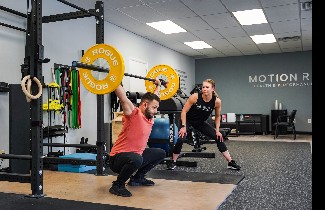
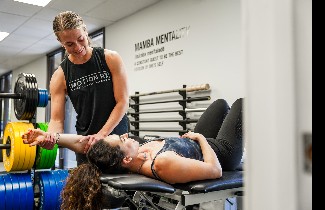
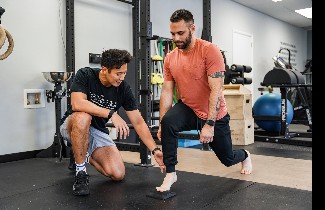
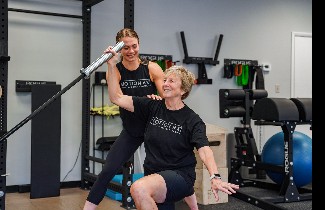
MOTION RX is a performance physical therapy clinic in Jacksonville, FL for athletes and active adults. Our mission is to get you back to the sports and activities you love pain free, faster and stronger, through an individualized 1 on 1 empowerment healthcare model.
Our 3 Step Process
Step 1: Identify the Root Cause of the Issue
-going beyond just treating symptoms, we identify the root cause of the issue and why it's occuring
Step 2: Implement an Individualized Plan for YOUR GOALS
-Together, we provide and implement a custom performance rehab plan based of your specific issues designed to get you back to YOUR performance goals.
Step 3: Provide a LONG TERM Solution
-We empower, teach, and give YOU the tools to prevent the same issue from coming back again so that you can MAINTAIN long term health, full of the activities you love pain free!
All of our healthcare doctors are athletes ourselves so not only do we value the importance of an active lifestyle but we also walk the talk.
Certifications our Clinicians hold
-OCS (Orthopedic Clinical Specialists)
-CSCS (Certified Strength and Conditioning Specialists)
-CF-L1 (Crossfit Level 1 Trainer)
-USAW-L1 (USA Weightlifting Level 1)
-TPI (Titlelist Performance Institute)
We offer a premium online physical therapy service aimed to provide a convenient and time-saving solution to your health needs or injury by seeing you in the comfort of your own home or office through an online HIPPA-compliant video chat!
We understand that you have a busy schedule an...
Here at MOTION RX, you get personalized 1 on 1 care and receive the full attention of a Doctor of Physical Therapy for 60-minute
We take the time to get to know you on a personal level, collaborate with you, educate, and empower you with the tools necessary to reach your goals.
VIEW MORE
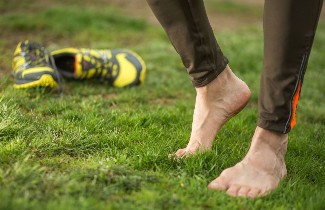
Strong athletes have strong healthy ankles! When it comes to movement...Read More
Strong athletes have strong healthy ankles! When it comes to movement and force production, our feet are the first thing that comes in contact with the ground. Because of this, ankle and foot health is essential in order to help the whole body move in an effective and efficient manner. Being the base and the place we produce force for jumping and running, ankle strength and stability should definitely have it’s place in your weekly training program. 3 basic pillars of maintaining a healthy ankle include appropriate dosing of strength, mobility, and plyometrics. This will not only improve your ability to produce force in your exercise performance but also in your everyday activities!
Strength
When it comes to performing just about any movement, it costs us some “energy dollars” from our overall energy bank account. Say for example, for every step we take costs 20lbs of energy on your ankle muscles, specifically your calf muscle complex via the Achilles tendon and surrounding tendons. When it comes to taking multiple consecutive steps at a fast rate (ex. running), you can imagine how fast and how much energy dollars we would end up having to use. One way to make sure we don’t ever run out of money (so we can continue doing all the activities we enjoy!) is to build up our energy bank account! What if you could perform a single leg calf raise with 100lbs for multiple reps? Then each time you take a step and it costs 20lb of muscle energy, wouldn’t it seems like chump change? Each step, stride, or jump we take all of a sudden becomes a submaximal effort, and is less taxing as your body requires less energy to complete the task. These 2 exercises below are some of our favorite options for improving strength at the ankle complex!
SL Calf Raises: https://www.youtube.com/watch?v=Mx9uhWJVrwY
Farmer Carries on Toes: https://www.youtube.com/watch?v=EFxgeZeNPqk
Mobility
Having limited ankle mobility in any direction may sometimes hinder your body from performing at their most optimal position. All muscles have an optimal length where they are strongest and able to produce the most amount of force. However, if you are already limited in these positions, your tissues may be forced to try to contract in a shortened, or weaker, position. When it comes to athletic performance, ankle dorsiflexion (foot pointed up) and ankle plantarflexion (foot pointed down) are going to be 2 of the most important positions you want to have access to. If you are an athletes and want to get the most out of your training, add these 2 ankle mobility drills into your movement prep before a leg day or a run for the best results!
Bench Assisted Dorsiflexion (Ankle DF): https://www.youtube.com/watch?v=7_BG3eed6a0
Hero Stretch (Ankle PF): https://www.youtube.com/watch?v=nbFJ_fEfknE
Plyometrics
As an athlete you’re most likely performing some sort of plyometric movement (ex. jumping, running, cutting) that requires elasticity and tendon involvement during force production and force re-absorption. While many HIIT workouts may include some form of high-intensity plyometrics, it is important to perform them outside of these workouts with intent and not under fatigue. By focusing on producing force from the Achilles tendon, you can improve it’s elastic capabilities and “springiness”, which ultimately is another form of building up your overall “energy bank account.” To improve Achilles tendon reactivity, try these exercises while focusing on spending as little time on the ground as possible!
Double POGOS: https://www.youtube.com/watch?v=Ks3JgoDLE6w
SL POGOS: https://www.youtube.com/watch?v=mNqlIcutvDw
Hopefully this gives you a solid starting point of building up some strong resilient ankles. Improving ankle and feet capacity is one of the best ways to minimize risk of ankle/foot injuries in the future. If you are dealing with any kind of nagging ankle or foot pain get in contact with us! We’ve helped HUNDREDS of athletes get back to the activities they love pain free!

1

0

1
you must login
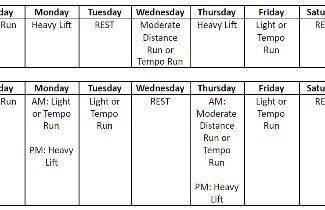
One question we get frequently asked is how to incorporate strength tr...Read More
One question we get frequently asked is how to incorporate strength training into a running schedule. From an early age of training, runners are not taught to have a solid strength training program along with their mileage. Starting in middle and high school, other sports have priority, and runners don’t learn how to balance the stress of aerobic (cardio) and anaerobic (resistance) training. They also may never learn proper form and never feel confident to pick up heavy weights in the gym. Fast forward to adulthood, these runners have missed out on the benefits of strength training and how it can make you faster and lighter on your feet.
So WHY is strength training important?
Having strong muscles makes every stride and movement easier. Your muscles have to produce a certain amount of force to contract, but if you can not only move your bodyweight but EXTRA weight on top, that makes every step you take during running and every squat a sub-maximal effort. Your body learns how to move more efficiency under that extra load. You’ll feel lighter on your feet and stronger doing everyday activities like carrying groceries and going up stairs. Each step during running can exert up to 4x your bodyweight, so it only makes sense to prepare your body to handle those loads!
So HOW do I run and strength train?
The answer to this question depends heavily on what your current training looks like and what your goals are. A recreational 5k runner and someone training for a half, full, or ultra marathon will look drastically different, but strength training is equally important for all groups. For someone with a typical training schedule of 3x/week including a long run, tempo/moderate distance run, and short run, heavy lifting should be performed at least 2x/week, allowing for full rest days as well. If you run more than 3x/week, one option is to perform strength training on the same day as the run to ensure you can take a full rest days while adding more running days. Two sample schedules are attached here:
Of course, the days can be adjusted to fit your schedule, but there are a few things to notice in this schedule above.


2


0


1
you must login
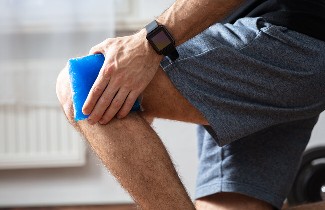
If you’ve ever hurt yourself or sustained an injury, you’v...Read More
If you’ve ever hurt yourself or sustained an injury, you’ve probably read somewhere on Google or heard a coach or doctor tell you to implement the method “R.I.C.E” (Rest, Ice, Compress, Elevate) in order to combat these soft tissue injuries and facilitate our bodies’ healing response. While this was meant for the acute phase of the injury (meaning JUST the first 24-72hrs), unfortunately we still see tons of people being misguided and utilizing this method weeks or even months into dealing with an injury!
In the British Journal of Sports Medicine (BJSM) in 2019, Dubois and Esculier proposed an updated acronym of “P.E.A.C.E and L.O.V.E” to assist in the management of musculoskeletal injuries through both the acute as well as subacute phases.
P.E.A.C.E. (acute phase) – AKA: Calm Shit Down

0

0

1
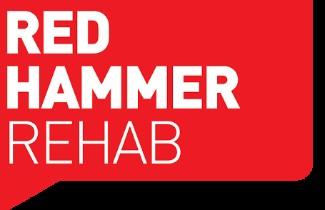 Michael Morrison
2 years ago
Michael Morrison
2 years ago
Just to add to this that I also send to many of my patients: Even the guy who invented RICE says it is no longer the best way to go about treating a strain/ sprain: https://www.washingtonpost.com/national/health-science/the-method-you-learned-for-treating-an-ankle-or-knee-sprain-is-probably-wrong/2016/05/27/f32e86ca-8c9b-11e5-ae1f-af46b7df8483_story.html
you must login
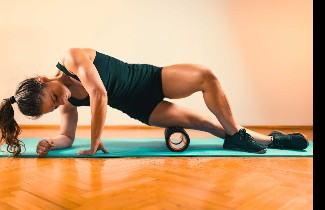
The IT Band is often times a commonly misunderstood area of the body....Read More
The IT Band is often times a commonly misunderstood area of the body. We often see the general public encouraging athletes and runners to foam roll and stretch out their IT band in hopes of increasing the length and pliability of the IT band, thus hopefully decreasing the discomfort or pain the athlete may be experiencing in their lateral thigh. In this article, we’re going to discuss the function of the IT Band and why it actually should be “tight” in order for it to be strong and create stabilization at the hip, knee, and thigh for athletes.
What Is The IT band and It’s Function
Before we discuss anything, we need to understand the IT band structure itself. The IT band is a structure along the lateral leg stretching from the hip to below the knee. It connects up top on the hip to both muscles and bones and has multiple attachment points on the thigh until it connects to both the knee and shin. The purpose of the IT Band is to stabilize the hip and knee joints through dynamic motions such as acceleration and deceleration. Over time, because of it’s function, the IT Band has actually adapted to become STIFFER in order to help us stand upright, and interestingly, DECLINES in stiffness for sedentary folks. Even more interestingly, horseback riders actually develop a similar structure along the inside of the thigh to adapt to stress patterns with saddle contact and riding. That’s just how adaptable the ITB and the human body is! So, if you are an athlete and typically a more active person in general who is putting more stress through their legs, (ex. runners and field sport athletes), you are naturally going to have a stiffer and tighter IT band in order to be able to support and be able to handle the dynamic forces going through the hips and knee.
Common IT Band Myths
1) IT Band Pain is Due to the IT Band Being Tight
Often times, is very common for runners with a high volume of downhill runners, or new runners to develop some lateral knee pain or tightness commonly attributed to the IT Band. In the past, people have commonly thought the IT band to be tight, and caused friction over the distal IT Band, thus leading to people to stretch and roll out the IT band as a treatment. However, we know that there is a fat pad with a ton of blood supply and nerve endings right where most people feel pain, which makes sense why the distal lateral end of the IT Band is commonly sensitive. This fat pad is meant to protect other sensitive tissues and maintain joint lubrication in high-stress areas like the knee. If it is compressed too much these nerve endings and blood supply are disrupted and pain is felt.
Therefore, if we already have an IT Band and lateral knee that is already aggravated, smashing or trying to “stretch” the already sensitive area would only aggravate and piss off the area even more. We also know that as a runner or athlete, the IT Band gets tighter and more stiff as a natural adaptation of our body in order to withstand the loads seen with higher impact activities.
2) You Can “Lengthen” and Physically make changes to " IT Band
Even if we were trying to “lengthen” and elongate the IT Band, we physically cannot. A study by Chaudry et. Al found that extremely large forces (>9,075N) were required to produce 1% change in fascia. That is basically the equivalent of hanging a F150 pickup truck off your IT Band! So the chances of us trying to achieve forces that high in order to “break adhesions” or “stretch” out our IT Band with a foam roller or stretches aren’t realistic.
Stretching or manual therapy may lead to relaxation changes and sensory changes that are due to stimulating receptors changing the overall tone of muscle, not necessarily creating a physical lengthening effect of the tissue. Stretching, laying on a table having someone massage you, or using a foam roller may temporarily feel good but there isn’t any solid evidence that any of these things create long-term soft tissue changes making them more pliable, less tight, and less painful.
How to Address IT Band Pain
1) Address load management
When one is experiencing IT Band Pain, we typically want to take a look at the workload volume around the same time that their symptoms started flaring up. Was there a sudden increase in running volume? Was there a sudden increase in squats or lunges in the programming? Was there a change in the running environment such as increases in uphill or downhill running or changing surfaces from concrete to trail. One of the many reasons why an athlete may experience sudden discomfort is possibly due to their current loading exceeding the capacity of their tissues at the hip and knee.
2) Improve Knee and Hip Strength
The way we approach this in rehab is to train the surrounding muscles targeting the hip and knee. We load heavy movements such as squats, lunges, and glute work, as well as starting to load dynamically. Meaning, we work on strengthening into deep knee and hip bending at various speeds to challenge those areas. For runners who have issues related to downhill running and MUST withstand those types of loads, this is CRUCIAL for preventing pain in the ITB. Having a rehab professional to figure out what areas you need to target is important, because these are general guidelines are not specific to you. Find someone who will take time to listen to what your specific situation is and can tailor a program to your needs that involves loading and strength training for athletes.
3) Address Biomechanics
For runners dealing with ITB pain, manipulating different variables such as step rate and cadence can be beneficial for distributing forces away from the knee. Research has shown by increasing step rate by about 5%, we can decrease the total shock absorption at the knee by about 20%. Manipulating biomechanical variables can be a good way to allow the athlete to continue training while rehabbing the injury.
Hopefully this clears up some of the common misconception that you may have heard in the past. If you’re experiencing pain limiting you from living the active lifestyle you want, get in contact with us! We want to help you live an active fulfilling life pain free!

0

0

0
you must login
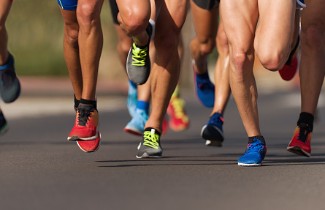
The Achilles tendon (AT) is a pretty cool tendon in our body that orig...Read More
The Achilles tendon (AT) is a pretty cool tendon in our body that originates from our Soleus muscle (a giant workhorse) for running and connects with the two bellies of the Gastrocnemius (another HUGE giant workhorse) during running before inserting onto the calcaneus or heel bone. Our achilles tendon is the largest and strongest tendon in the human body as it has to withstand upwards of 12x body weight load during running!)
Given the demands placed on the AT, it’s not surprising that it’s commonly affects runners. This often manifests as a “tendinopathy,” which is an umbrella term used to describe pain and injury to the tendon typically when the current capacity of the tendon has been exceeded. Regarding tendinopathy, the tendon can progress or regress down the continuum based on the loads it is exposed to until at either ends of the spectrum we have a “rupture” or a “healthy tendon.” The most common phases we see people dealing with tendon pain are when they are in reactive , disrepair, and degeneration. With the tendon being in the reactive or disrepair phase, we can actually reverse it structurally back up the continuum towards a healthy normal tendon. However, when the tendon reaches degeneration phase or rupture, there is nothing physically we are able to do to change the actual structure of the tendon. But what we CAN do is improve the cross sectional area and collagen fibers of the SURROUNDING tendons which can ultimately improve overall tendon FUNCTION, allowing you to get back to the activities you want to be able to do pain free!
With achilles tendinopathy we have two big main types. We have mid insertional which is the main one that everyone thinks about right, right in the middle of the Achilles tendon, and we also have insertional achilles tendinopathy where we are dealing with it a bit lower where the tendon inserts on the calcaneal heel.
Because of the insertion site, compression is typically a lot more sensitive and painful in insertional achilles tendinopathy rather than mid insertional achilles tendinopathy. Compression at the achilles tendon typically occurs in end range dorsiflexion where we have the toes pointed upward. So common rehab movements in end range DF such as ankle DF stretching, as well as deficit heel raises, can actually flare up insertional achilles tendinopathy even more when you dose those in too early! So it’s super important to distinguish between the two types early on in order to know how to appropriately dose exercise and load the tendon in a meaningful manner.
When it comes to management of Achilles Tendinopathy we typically like to separate into 2 different phases. Phase 1: Calm Shit Down. Phase 2: Build Shit Back Up.
Phase 1: Calm Shit Down
· we typically want to temporarily remove stressors that aggravate and are sensitive (Typically this relates to plyometric energy storage/release movements such as jumping, hopping, running, uphill running, speed work etc.)
· manipulate different variables such as (mileage, speed, type of environment) to allow the athlete to continue training within tolerance in order to prevent deconditioning
· minimizing compression for insertional achilles tendinopathy (avoiding end range calf stretches) and maybe even putting in a heel lift to allow the heel to go into a bit of plantarflexion from neutral if it’s really aggravated.
Phase 2: Build Shit Back Up
Things such as PRP, shockwave therapy, corticosteroids, and NSAIDs all have been shown to be less effective than exercise. Tendons respond to load and so when looking to improve overall capacity of the tendon, we want to dose it with different exercise variations to the gastroc, soleus, and overall achilles complex. We can split up loading progressions into 4 different stages:
Stage 1 (Isometrics)
ex. Calf raises (hold)
Stage 2 (Isotonics - eccentrics, concentric, HSR (heavy slow resistance)
ex. Deficit Calf raises (isotonics)
Stage 3 (Energy Storage Exercises - plyometrics)
ex. Double Leg POGO hops
Stage 4 (Return to Sport)
All of these are phenomenal options in terms of finding the appropriate entry point of loading where we’re dosing enough to increase the strength of the tendon and not doing too much and overloading the tendon. Entry point of loading will vary based on where the tendon is on the continuum as well as level of sensitivity and other stressors as well.
Major Keys to Consider with Tendon Injuries
Treat the Donut - not the Hole! - Focus on improving tendon FUNCTION not structure!
Be Patient and Trust the Process! - Find a great physio who can help guide you through the process and be patient. Know that it can take up to 12 weeks for physiological adaptations and changes to occur!
Load the Tendon! - Tendon’s respond to load and in order to improve tendon capacity, we need to be loading the tendon >70% 1RM intensity to elicit appropriate adaptation.
Manipulate Different Variables to Continue Training! -Manipulate different factors such as training volume, frequency, and duration in order to continue to stay active and prevent de-conditioning!
Stay Positive and Count the Small Wins! - Managing and getting through tendinopathy injuries definitely is no easy task and it’s important to stay positive! Don’t let this one injury define who you are. Count the small wins and keep trucking along! You got this!
If you’re a runner dealing with achilles issues or heel pain, get in contact with us! We have helped hundreds of runners get back to running pain free and hit PRs in their races without any issues and we want to do the same for you!

1

0

0
you must login
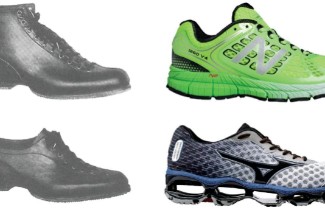
The purpose of this blog is to discuss how we came to the modern shoe...Read More
The purpose of this blog is to discuss how we came to the modern shoe today; vibrant colorways, cushion, fancy laces, and so on. I also want to discuss how the shoe industry has done a FANTASTIC job at confusing the consumers into spending money on shoes that they feel will “fix” their foot posture during running, and how doctors and shoe companies have intertwined pain and shoe wear in the mind of the consumer.
Often times, is SO common to feel overwhelmed, confused, and distracted by flashy colors and brands when you go in the running store. Of course we all love shoes that “look cool”, or I have heard many runners who match their shoe to their outfit. We can get sidetracked and end up picking a shoe that has too many bells and whistles, when really we just want something between our precious feet and the road. My goal of providing this information is for more people to have basic knowledge of why shoes are the way they are today, and what basic things you need to remember when shopping for shoes.
This is a more historical version and in-depth version of our PAIN FREE RUNNING GUIDE, that you can download HERE.
From Clod Hoppers to Frog Feet: A Quick History
There is a beautiful side-by-side of what running shoes were in 1912 and what they have evolved into now in 21st century. You think that your feet take a beating now? We have slowly developed shoes to be softer and more cushioned, to the point where some people describe shoes as “running on clouds”.
In the mid-70s podiatrists gathered and discussed why they thought runners had so many ankle, foot, and knee injuries. They collectively decided it HAD to be due to too much impact or pronation (2). They also decided to give shoe recommendations based on foot shape, and this continues today. The industry continued to not only be shaped by the conjecture of doctors but of the popularization of running shoe fashion, including the building of brands such as Adidas and Nike.
As you can see, things such as non-science related like book publishings (loved Born to Run) greatly impacted the way shoes were being discussed and used in the general population. It turned out that as soon as Born to Run came out everyone wanted minimalist shoes, and did not properly transition from their previous cushion shoes (2). Not allowing your muscles and bones to gradually build up resilience to less cushion lead to injuries, where it is now commonly understood that if you transition types of shoes you must follow a transition. Unfortunately, non-evidence based publications like these led people to be more confused than they were before about what they really should be wearing, or how to transition into what they wanted to wear.
Matching Cinderella’s flat foot to the glass slipper: does it prevent injury?
To this day, many individuals still correlate foot dysfunctions to footwear, and assume that with a specific foot shape they need a specific shoe. This partially has to do with the original podiatrists who believed that poor foot mechanics and foot posture were the root cause of injuries, and therefore shoes were made to accommodate those movements or prevent them from occurring at all. However, the research tends to point towards the opposite direction and that wearing a certain particular shoe has no relationship and correlation towards decreasing injuries.
There was a large study conducted with the U.S. Military where over 1,000 individuals were assessed for foot type according to these examples (3-5):
If you have high arched feet? ——> You need a cushioned shoe,
If you have flat arches? ——> Your feet need some support with rigid insoles and a motion control shoe.
If you fit in neither of these categories and just have a deemed “medium” arch? ——> Try out a stability shoe.
Even though each individual was matched to their prescribed shoe based on what the industry understood at the time, it DID NOT predict injury risk and did not prevent injury regardless of gender or foot type (3-5). This reinforces the current understanding that to prevent pain and injury, a shoe is not going to be the band-aid to fix these problems. Adequate preparation, proper training, load management, and recovery are the keys to a successful running program. We have come to understand that pain and injury are much more complex than a simple shoe prescription. It is a matter a person’s training, life, beliefs, and so on.
While the latest technology, designs, and cool colorways may all seem alluring and “sexy”, the number one thing that reigns supreme in terms of finding the best running shoe will be COMFORT. Having a comfortable shoe will allow you to spend more time on your feet for longer, better runs. So experiment! Try out a range of shoes ranging anywhere from the high arch support cushioned Hokas to the minimalistic shoes! With this knowledge, I hope you have a bit more understand of what you should look for the next time you head to your favorite store to pick up a new pair of running shoes!
Nigg B, Baltich J, Hoerzer S, et al. Running shoes and running injuries: mythbusting and a proposal for two new paradigms: ‘preferred movement path’ and ‘comfort filter’. Br. J. Sports Med. 2015;49:1290-1294.

0

0

0
you must login
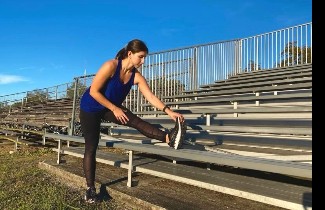
Running is one of the most popular form of exercise around the world a...Read More
Running is one of the most popular form of exercise around the world as it can provide a ton of health benefits and has a low barrier of entry to starting. Unfortunately, there are a ton of running related injuries (RRI) that affect both competitive and recreational runners each year, limiting them from performing at their best potential.
While running related injuries are often multi-factorial, one of the main reasons why athletes experience an injury is due to inefficient progression of running loads. The human body is extremely remarkable in terms of being able to adapt when provided with the right amount of stress. When a certain stress is applied to the human body, the body will respond by trying to adapt to the added stressor. If the stimulus is too low, the body won’t adapt, too high of the stimulus, and our tissues can’t adapt fast enough and possible injuries can occur. Just with any kind of sport or activity such as training for a marathon or an Olympic weightlifting meet, you need to have the right program and progression to provide your body with the “optimal” stimulus in order to achieve the best performance while minimizing injury risk.
One of the most popular running progressions is the “10% Rule” where it states that athletes looking to increase their weekly running workload mileage should only increase in increments of 10%. (ex. If you’re running 30miles total in 1 week, you should only run 3 more miles (33miles) the following week). Unfortunately, the 10% Rule is a very generalized form of progression and we see that athletes in a study by (Buist et. Al, 2008) who utilized the 10% rule, did no better than a unsupervised running program, which resulted in both groups having a 20% injury rate in novice runners.
A better way to manage running workloads would be look at an athlete’s Acute:Chronic Workload ratio as a means of assessing the athlete’s current and past training history, levels of fatigue, and their readiness and ability to progress. It allows us to measure an athlete’s current workload stress on the their body and compares it to the long term workload stress on the body to examine what they have previously done and what they are prepared to do. The acute workload can be measured as the amount of work the body has performed in the last 7 days and the chronic workload is the average amount of work the body has performed in the last 4 weeks. A recent systematic review in February 2020 (Maupin et. Al 2020) took a look at athletic workloads across multiple different sports and saw that an Acute:Chronic workload ratio (ACWR) between 0.8-1.3 was the best range to improve performance while maintaining a low injury risk while a ratio greater than 1.5 resulted in increased injury risk.
The good thing about utilizing ACWR is that it also allows us to factor in subjective fatigue to autoregulate training as this can allow us to account for external factors such as nutrition, life stressors and sleep) all of which can affect performance. This can be done by utilizing RPE (Rate of Perceived Exertion) into the ACWR formula. The level of difficulty or RPE (Rate of Perceived Exertion) is a scale from 0-10 where 0 is basically resting while 10 would be the hardest race they’ve ever ran. Athletes can basically take their most recent run and give it a RPE rating for their training that day.
For running, we can calculate the chronic workload as the average (miles or time ran) x (difficulty of the run) for each week over the last 4 weeks
For each week the weekly running loads would be calculated and the last months work would be averaged together to find the running loads
Ex.
Week 1: 1275
Week 2: 1400
Week 3: 1550
Week 4: 1350
Average Chronic Load: (1275 + 1400 + 1550 + 1350) / 4 = 1394
Week 5: 1600 (Acute Workload)
Acute:Chronic Workload Ratio: 1600: 1394 = 1.14
Athletes and coaches can utilize this as a rolling model to view and monitor workloads, as well as utilize it as a helpful insight into training load progressions and periodization. Obviously each athlete will vary differently based on their own individual adaptability, but for the regular runner just starting out, staying between the 0.8-1.3 range will be an ideal place to start. “Running too much” and “high training workloads” may not be a cause or problem of increased injury risk but rather HOW you get to those high training workloads may be the issue. How you increase your training and whether or not you’re maintaining a solid chronic workload will be bigger factors that help protect you from future injuries.
If you’re an athlete who has been experiencing long histories of running injuries, I highly encourage you to implement this into your training. This could be what changes that pattern!

0

0

0
you must login
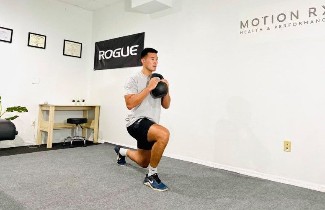
BFR or Blood Flow Restriction is the application of a tourniquet syste...Read More
BFR or Blood Flow Restriction is the application of a tourniquet system to a proximal arm/leg which is inflated to a specific pressure (80% of Limb Occlusion Pressure (LOP) in LE and 50% of LOP in UE) in order to reduce blood flow during exercise. By limiting blood flow and oxygen to the area, we can mimic the metabolic demands and environment, and reap the same strength/hypertrophy benefits as if we were training at a high intensity but without actually needing to utilize heavy resistance or weights.
History of BFR

1

0

0
you must login
MOTION RX is a performance physical therapy clinic in Jacksonville, FL for athletes and active adults. Our mission is to get you back to the sports and activities you love pain free, faster and stronger, through an individualized 1 on 1 empowerment healthcare model.
Our 3 Step Process
Step 1: Identify the Root Cause of the Issue
-going beyond just treating symptoms, we identify the root cause of the issue and why it's occuring
Step 2: Implement an Individualized Plan for YOUR GOALS
-Together, we provide and implement a custom performance rehab plan based of your specific issues designed to get you back to YOUR performance goals.
Step 3: Provide a LONG TERM Solution
-We empower, teach, and give YOU the tools to prevent the same issue from coming back again so that you can MAINTAIN long term health, full of the activities you love pain free!
All of our healthcare doctors are athletes ourselves so not only do we value the importance of an active lifestyle but we also walk the talk.
Certifications our Clinicians hold
-OCS (Orthopedic Clinical Specialists)
-CSCS (Certified Strength and Conditioning Specialists)
-CF-L1 (Crossfit Level 1 Trainer)
-USAW-L1 (USA Weightlifting Level 1)
-TPI (Titlelist Performance Institute)
Training Block was created with a mission to support and empower runners, in order to elevate our sport. We do so by giving runners access to a network of local sport performance providers, who provide runners with the care they need from coaching, physical therapy, massage, strength training, and more. We also give providers an easy way to connect with each other and share articles, videos, and other resources that benefit runners and providers alike. For every service booked through Training Block, we donate 10% of our revenues to Training Block’s Elite Athlete Fund, which sponsors elite runners who do not have professional contracts and need financial support for racing at their highest level.
Copyright © 2024 Training Block. All rights reserved.
Refer a friend and get $5 discount on order!

Need this info badly- thanks!